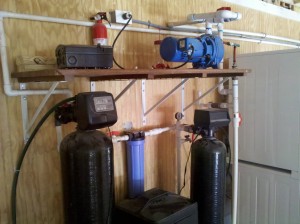Understanding Salt Water intrusion in the Lowcountry Shallow Aquifer (Stratum)
This post is in reference to one of the most misunderstood aspects of well drilling in the Lowcountry of South Carolina…Salt Water intrusion.
So you had a well drilled and it is relatively shallow. Your driller may have advised you that shallow water was best in this area, and it usually is! James Island, Johns Island, Wadmalaw, Edisto Island, Meggett, Ravenel, Mt. Pleasant, West Ashley, Awendaw all have mostly shallow wells serving the needs for potable drinking water. Most of these wells are incredibly pure, but as you move close to the creeks and marshes, things can change rapidly.
Shallow wells are considered shallow because they are less than 50 ft. and the water tables rise high enough for a jet pump or centrifugal pump to lift the water with reasonable efficiency. Casing size varies, as well as construction methods. Most are screened and gravel packed to prevent sand from being pumped. The water contained is rainwater that has been stored in the sand layers. Minerals come from the old ocean floor and vary as widely as an old ocean floor! No one can predict exactly what one of these shallow wells will produce – quantity or quality. Proper construction techniques will ensure the well will not pump sand or be mixed with a more shallow layer that may contain more contaminants. It is best to use a certified water well driller to drill even a shallow well for irrigation. You would be surprised at the knowledge a certified driller must have in order to drill wells in this state. The cost of a professional well will pay for itself with years of trouble-free use.
Shallow water, besides the ability to become contaminated with salt water, also has high contents of iron, hardness and sulfur or all of them, which can make for expensive treatment options by themselves. Combine any one of these with salt water and its treatment becomes nearly impossible.
Reverse Osmosis is needed for the treatment of salt water contamination. In order to properly design a system that will last for years, all of the hardness and iron must be treated to prevent membrane failure (the most expensive part of the system). A considerable flow must also be obtained, if you have to pre-treat for iron or hardness since a conditioner needs to be backwashed. Sometimes these shallow wells have issues with obtaining flow needed to uphold consistent backwashes and trying to supply a reverse osmosis. Its at this point where a deep well begins to make a lot of sense.
This is why we recommend converting to a deep well, which in the lowcountry of SC, generally does not contain any hardness to amount to much. Iron content is generally low, if the casing has been installed properly (used a quality driller who uses bentonite [not portland cement] to seal his casings). A Deep well will produce a large quantity of clean water that may have high levels of sodium chloride in it. The pump will then push the water at high pressure through the Reverse Osmosis Membranes and the purified water will flow to a holding tank for storage. A pump inside this tank will then pressurize the home with nearly 100% pure water.
It is at this point that the shallow water well should be abandoned, because the chances that it will become fresh again are limited. The casing and screen should be filled with 20% solids bentonite to prevent the ground from becoming a potential contamination point.
If you really wanted to use the salty well, I hear it makes good Boiled Peanuts and useful to soak fresh local Bulls Bay or Edisto Oysters. Beyond that, it would be useless:-)
Thanks for reading,
Jody Anderson
Owner of J.P. Anderson Well & Pump LLC
jpandersonwell.com
843-889-8675

